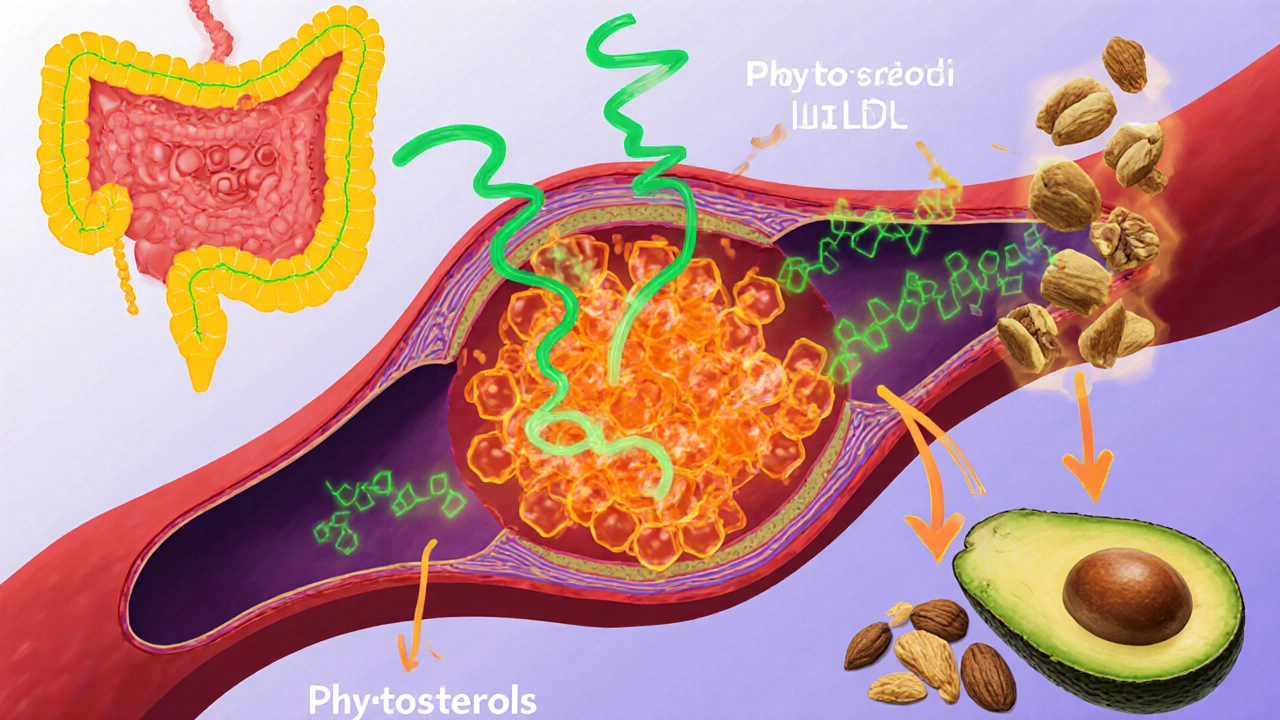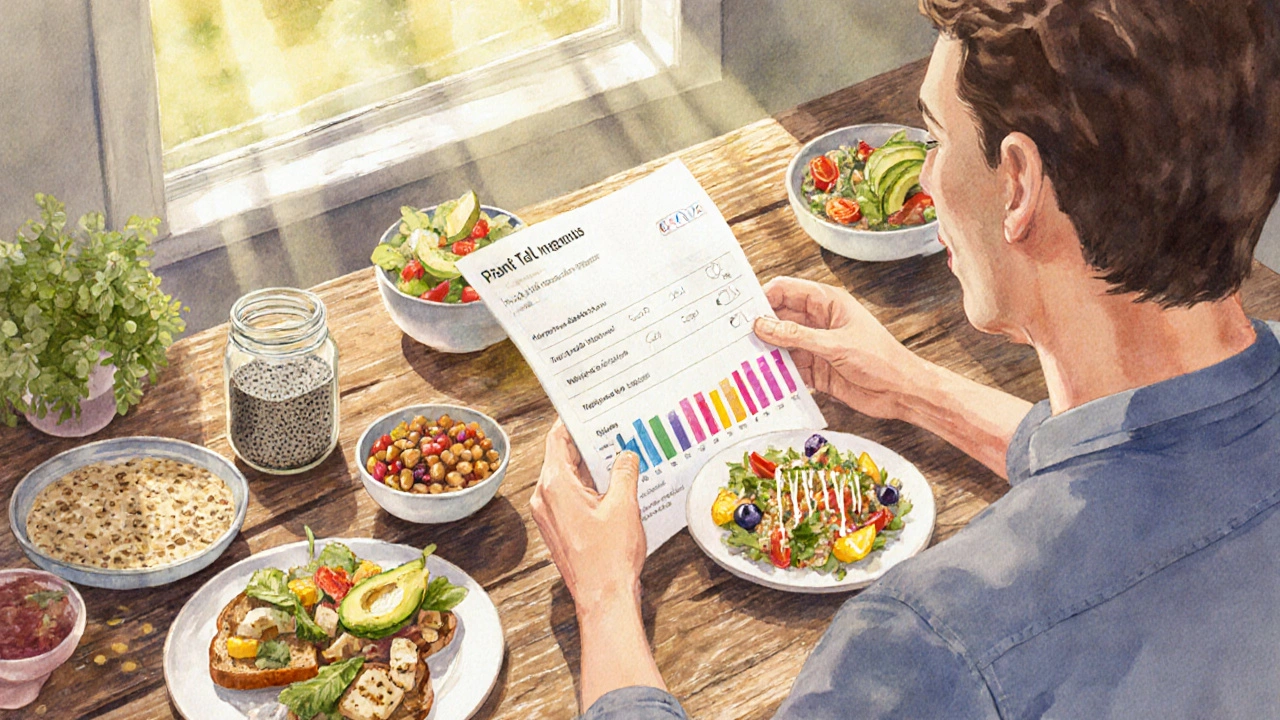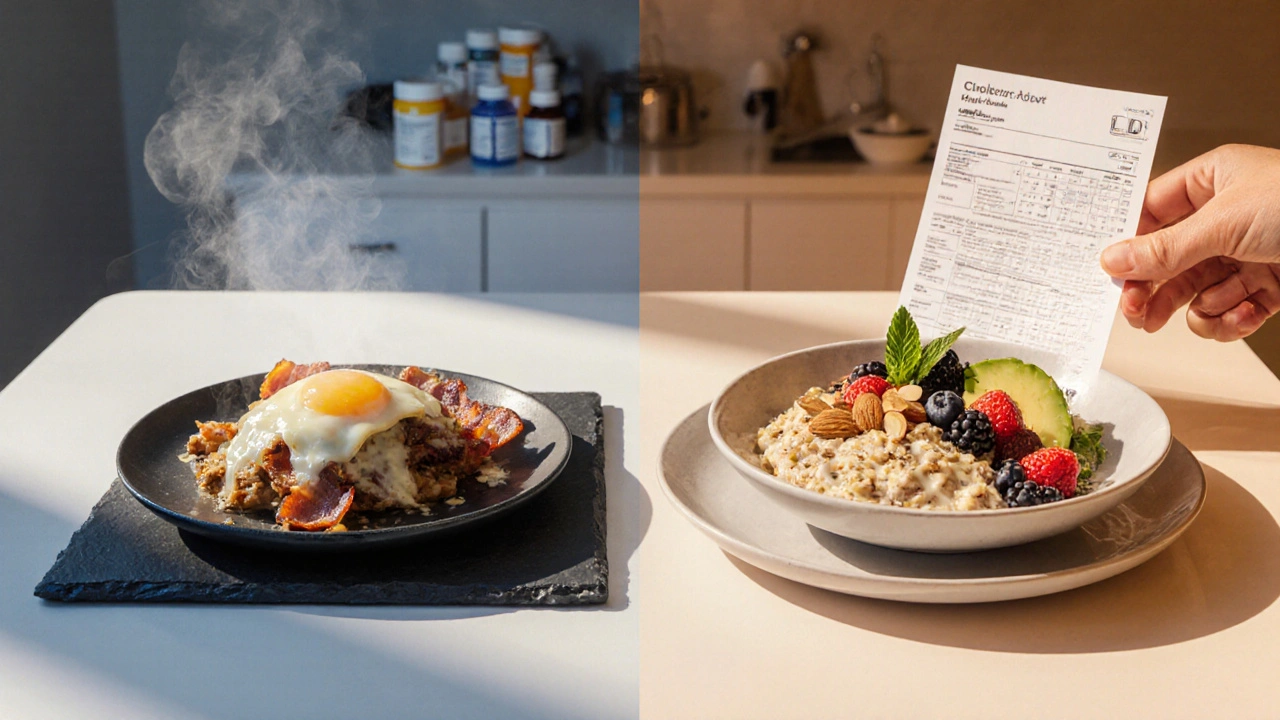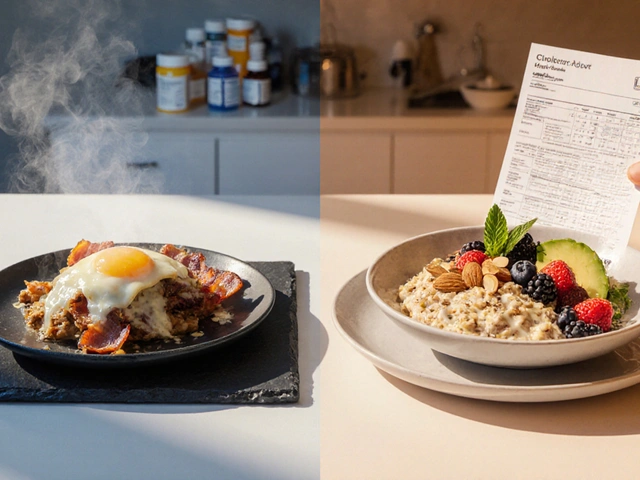Plant-Based Diet Cholesterol Reduction Calculator
Estimated LDL Cholesterol Reduction
0% reduction in LDL cholesterol
This represents a clinically significant drop that can reduce heart disease risk.
If you’ve been told your cholesterol is too high, you might think medication is the only answer. In reality, a plant-based diet is a diet centered on fruits, vegetables, legumes, nuts, seeds and whole grains while minimizing animal products can drop dangerous numbers without a prescription. Below you’ll see why, which foods pack the most punch, and how to turn the science into a daily eating plan you can actually stick to.
Why a Plant-Based Approach Hits Cholesterol Hard
The key player in the cholesterol story is low-density lipoprotein (LDL). LDL is the “bad” cholesterol that builds up in artery walls and fuels heart disease. A plant‑focused plate attacks LDL in three concrete ways:
- Fiber overload: Soluble fiber binds to bile acids, forcing the liver to use more cholesterol to make fresh bile. The result? About a 5‑10% drop in LDL for each 5‑gram increase of soluble fiber per day.
- Phytosterol competition: Plant sterols look like cholesterol to intestinal cells, crowding out real cholesterol absorption. Consuming 2g of phytosterols daily can shave 7‑10% off LDL.
- Healthy fats shift: Nuts, seeds and certain oils replace saturated fats, nudging the ratio of LDL to high-density lipoprotein (HDL) in a favorable direction.
All three mechanisms are backed by large cohort studies and randomized trials published since 2018, showing average LDL reductions of 12‑15% when participants switched from a typical Western diet to a whole‑food plant‑based regimen for six months.
Top Cholesterol‑Lowering Plant Foods and Their Numbers
Not every veggie is created equal. Here are the headline stats that matter when you’re fighting high cholesterol:
| Food | Key Nutrient | Typical Serving | LDL Reduction* (average) |
|---|---|---|---|
| Oats | Soluble fiber (β‑glucan) | ½ cup cooked | 5‑7% |
| Barley | Soluble fiber | ½ cup cooked | 4‑6% |
| Almonds | Monounsaturated fat & plant sterols | 1oz (≈23 nuts) | 3‑5% |
| Soy protein (tofu, tempeh) | Isoflavones & protein | ½ cup | 4‑8% |
| Legumes (lentils, beans) | Soluble fiber + protein | ½ cup cooked | 5‑9% |
| Avocado | Monounsaturated fat | ½ fruit | 2‑4% |
*Numbers reflect average change in LDL after 8‑12 weeks of daily consumption in controlled trials.

Putting It All Together: A Sample 7‑Day Menu
Seeing the data is one thing; eating it is another. Below is a practical week‑long plan that hits at least three cholesterol‑lowering nutrients each day.
- Day1: Overnight oats with chia seeds, berries, and a splash of soy milk. Lunch - mixed bean salad with olive‑oil vinaigrette. Dinner - stir‑fried tofu, broccoli, and brown rice.
- Day2: Whole‑grain toast topped with avocado and sliced tomato. Snack - a handful of almonds. Lunch - lentil soup with carrots. Dinner - quinoa bowl with roasted veggies and a tahini drizzle.
- Day3: Smoothie (spinach, banana, oat milk, flaxseed). Snack - apple slices with peanut butter. Lunch - barley tabbouleh with parsley and lemon. Dinner - baked sweet potato, black beans, and salsa.
- Day4: Scrambled tofu with bell peppers and mushrooms. Snack - roasted chickpeas. Lunch - kale‑chipotle salad with pumpkin seeds. Dinner - whole‑grain pasta tossed in tomato‑basil sauce, topped with nutritional yeast.
- Day5: Buckwheat pancakes with fresh fruit. Snack - mixed nuts. Lunch - tempeh wrap with lettuce, cucumber, and hummus. Dinner - cauliflower “steak” with almond‑pesto.
- Day6: Muesli with soy yogurt and dried apricots. Snack - carrot sticks and guacamole. Lunch - split‑pea soup. Dinner - stir‑fry tempeh, bok choy, and soba noodles.
- Day7: Fruit salad with a drizzle of hemp‑seed oil. Snack - edamame. Lunch - bean‑taco bowl with corn, salsa, and avocado. Dinner - roasted Brussels sprouts, lentils, and a side of wild rice.
Notice the repetition of oats, barley, legumes, nuts and soy - the heavy‑hitters for LDL.
Common Pitfalls & How to Dodge Them
Switching to a plant‑centric menu sounds easy, but a few traps can blunt the cholesterol benefits:
- Relying on processed meat analogues: Many veggie‑burgers are loaded with refined carbs and sodium, which can raise triglycerides. Stick to whole foods.
- Skipping healthy fats: If you replace butter with low‑fat cheese but never add nuts or avocado, you lose the monounsaturated‑fat advantage for HDL.
- Under‑eating fiber: Aim for at least 25g of total fiber daily; otherwise the bile‑acid recycling effect weakens.
- Neglecting VitaminB12: While not a cholesterol issue, B12 deficiency can cause fatigue that makes diet adherence harder. A modest supplement (25‑50µg) keeps you on track.
Address these early, and you’ll notice a steadier drop in total cholesterol and LDL.

How to Measure Success and Stay Motivated
Blood work is the gold standard. Here’s a simple tracking framework:
- Baseline lipid panel before you start.
- Repeat after 8‑12 weeks of consistent eating.
- Log total cholesterol, LDL, HDL and triglycerides.
- Celebrate any ≥10% reduction in LDL - it’s a clinically meaningful shift.
- If progress stalls, tweak one variable: add a tablespoon of ground flaxseed, increase nut servings, or swap refined grains for whole‑grain options.
Most readers see measurable improvement within three months, especially when they pair the diet with regular aerobic activity (150minutes/week).
Key Takeaways
- A whole‑food plant‑based diet can lower LDL by 12‑15% without medication.
- Soluble fiber, phytosterols and healthy fats are the three science‑backed mechanisms.
- Oats, barley, almonds, soy, legumes and avocado deliver the biggest cholesterol drops.
- Stick to minimally processed foods, hit 25g+ fiber daily, and don’t forget a B12 supplement.
- Track your lipid panel every 2‑3 months to see real progress and keep motivation high.
Frequently Asked Questions
Can a plant‑based diet replace cholesterol‑lowering medication?
For many people with mild to moderate hypercholesterolemia, a well‑planned plant‑based diet can achieve LDL reductions comparable to low‑dose statins. However, anyone with very high levels or a history of heart events should keep their doctor in the loop. Medication may still be needed while you transition.
How much soluble fiber do I need each day?
Aim for 8‑10grams of soluble fiber daily. That’s roughly a half‑cup of cooked oats, a half‑cup of boiled beans, or a large apple with skin.
Are plant sterol supplements necessary?
If you can eat fortified spreads, juices or yogurts that contain 2g of sterols, you’ll likely get the same benefit. Supplements are optional; whole foods like nuts and seeds also provide a modest amount.
Will cutting animal protein raise my triglycerides?
Not if you replace animal protein with legumes, soy or nuts and keep added sugars low. In fact, many studies show triglycerides fall when refined carbs are swapped for fiber‑rich plant foods.
How long does it take to see a blood‑test change?
Most individuals observe a measurable LDL drop after 8‑12 weeks of consistent eating. The biggest shifts occur in the first three months, then plateau.



Ian Howard
October 8, 2025 at 14:47Think of your arteries as highways and LDL as the traffic jam that slowly builds up. A plant‑based diet drops the speed limit on that jam by loading your meals with soluble fiber, phytosterols, and unsaturated fats. Oats, barley, beans, almonds, and avocado each pull cholesterol out of the bloodstream like magnets. Aim for at least 25 g of total fiber a day and sprinkle in 2 g of plant sterols, and you’ll see the LDL numbers start to dip. Pair this with regular cardio and the results can rival a low‑dose statin without the side‑effects.
Chelsea Wilmer
October 9, 2025 at 10:13We stand at the crossroads of nourishment and mortality, where every forkful votes for the future of our vessels. The humble oat, with its beta‑glucan, whispers to the liver, urging it to conjure fresh bile from cholesterol reserves, thereby lowering the circulating evil. Phytosterols, those botanical impostors, masquerade as cholesterol and bar the intestines from stealing our precious lipid treasure. Imagine the gut as a grand ballroom where fiber and sterols perform a waltz, each step pushing the other deeper into excretion. When we replace saturated butter with a smear of avocado, we are not merely swapping flavors but shifting the very chemistry of HDL and LDL. The scientific chronicles since 2018 tell a tale of 12‑15 % LDL reduction across diverse populations, a statistical echo of ancient herbal wisdom. Yet the modern skeptic, clutching prescription bottles, often dismisses this quiet revolution as anecdote. In truth, the data are fortified by randomized controlled trials, meta‑analyses, and the lived experiences of countless patients who have reclaimed health without pills. To ignore soluble fiber is akin to refusing the sunrise because the night was cold. The gut microbiome, fed by legumes and seeds, becomes a thriving metropolis that metabolizes bile acids into harmless compounds. This microbial alchemy further depletes the cholesterol that would otherwise clog arterial walls. Moreover, the inclusion of nuts and seeds introduces monounsaturated fats that coax HDL upward, balancing the lipid ledger. The diet, therefore, is a triad of mechanisms-binding, blocking, and balancing-each reinforcing the other in a symphonic crescendo. If one were to chart a course through this nutritional landscape, the map would be marked by oats, barley, soy, beans, almonds, and the occasional splash of olive oil. The moral imperative, then, is to embrace whole, minimally processed plant foods as a daily rite, for in doing so we sculpt a vascular future less besieged by disease. Let us, therefore, sit at the table of evidence, fork in hand, and partake in the feast that heals.
David Stout
October 10, 2025 at 05:40Hey team, give yourself a pat on the back for even thinking about ditching the meat‑loaded plates! You’ve got the power to rev up your cholesterol‑fighting engine by loading up on beans, oats, and a handful of nuts every day. Start with a simple swap-trade that bacon‑egg breakfast for a bowl of steel‑cut oats with chia seeds, and feel the energy surge. Keep the momentum by prepping a big batch of lentil soup on Sunday; you’ll have a cholesterol‑busting lunch ready for the week. Remember, consistency beats perfection; even small daily wins add up to a massive drop in LDL. Stay pumped, stay plant‑powered, and watch those numbers fall like dominoes.
Pooja Arya
October 11, 2025 at 01:07In the grand theater of nutrition, we are cast as both actors and audience, bearing witness to the moral decay of indulgent animal excess. To champion a plant‑based life is to proclaim a solemn oath to the planet, to our kin, and to the fragile sanctity of our own bodies. When you choose oats over processed meats, you are not merely feeding yourself-you are performing an act of ethical rebellion against the tyranny of cholesterol. The bitter truth is that each saturated bite is a silent accomplice to arterial siege, a betrayal of our collective health. Let us rise, with beans as our banners and avocado as our armor, and march toward a future where LDL no longer reigns supreme. The drama is real, the stakes are life‑long, and the script is yours to write.
Sam Franza
October 11, 2025 at 20:33Fiber is key, eat oats daily.
Raja Asif
October 12, 2025 at 16:00Stop buying foreign “health” trends and start eating the real stuff we grow in our own fields-whole grains, local legumes, and indigenous nuts. The western diet is a poison that inflames our arteries, and you can’t cure it with fancy supplements from abroad. If you truly love your country, protect its people by rejecting the cholesterol‑laden meat industry and embracing the plant‑based heritage we already have. Your veins will thank you, and so will the nation.
Matthew Tedder
October 13, 2025 at 11:27I hear you, making big changes can feel overwhelming, but you’re not alone on this journey. Start small: swap your usual sandwich bun for a whole‑grain wrap filled with hummus and veggies. Celebrate each win, no matter how tiny, because consistency builds confidence. If you slip up, simply get back on track-kindness to yourself fuels lasting habits. Together we can create a community where plant‑based living is the norm, not the exception. Keep moving forward, one delicious bite at a time.
Cynthia Sanford
October 14, 2025 at 06:53Yooo, this plant thing is lit! 🤩 I switched to oat milk and almond butter and felt sooo much better. No more blah‑blah cholesterol worries-just yum vibes. Keep it goin, fam! 🌱💪
Yassin Hammachi
October 15, 2025 at 02:20When we contemplate the interplay of diet and vascular health, we uncover a delicate equilibrium akin to a philosophical balance between desire and restraint. Soluble fiber functions as a mediator, drawing cholesterol into a constructive dialogue with bile production, while phytosterols adopt the role of a sage, gently guiding absorption toward moderation. The inclusion of monounsaturated fats, as found in avocado, further refines this discourse, elevating HDL in a harmonious exchange. Thus, the plant‑based paradigm presents not merely a dietary shift but an ethical contemplation of how we engage with our bodies and the world.
Michael Wall
October 15, 2025 at 21:47It’s clear that the modern diet is a betrayal of common sense; we should eat simple, whole foods and not be fooled by processed “health” hype. Oats, beans, nuts – these are the real heroes that keep our arteries clean. If you keep ignoring this, you’re just digging your own grave.
Christopher Xompero
October 16, 2025 at 17:13Wow, you really think a bowl of oatmeal is the ultimate cure‑all? That’s cute. While your poetic prose sings about fiber, the reality is that most folks can’t even stick to a single serving without sugar‑laden add‑ons. The drama of “plant‑based salvation” often masks the fact that you still need discipline, not just pretty words. And let’s be honest, the world isn’t going to magically transform because you read a study. It’s about consistent action, not just lyrical bragging.
Irene Harty
October 17, 2025 at 12:40It must be noted, dear compatriot, that the purported “benefits” of plant‑based nutrition are frequently disseminated by hidden agendas orchestrated by pharmaceutical conglomerates seeking to maintain market dominance. The selective presentation of data, coupled with the omission of conflicting studies, suggests a coordinated effort to manipulate public perception. One should therefore approach such claims with a measured degree of skepticism, lest we become unwitting participants in a grander scheme of metabolic control.
Jason Lancer
October 18, 2025 at 08:07Sure, “Fiber is key, eat oats daily,” but that’s the bare minimum. If you want real change you need to think beyond oatmeal-integrate legumes, nuts, and a variety of whole grains. Just stating the obvious doesn’t move the needle, but I guess it’s a start.
Brooks Gregoria
October 19, 2025 at 03:33While everyone is gushing about the cholesterol‑lowering magic of plants, let’s not forget that cholesterol itself is essential for hormone synthesis and cell membrane integrity. Eliminating animal products entirely may deprive the body of vital nutrients like vitamin B12, DHA, and certain saturated fats that actually support HDL formation. A balanced omnivorous approach, with mindful portion control, can achieve comparable LDL reductions without the risk of nutritional deficiencies. So, before you jump on the plant‑only bandwagon, consider the nuanced reality that a little animal protein may be beneficial.
Sumit(Sirin) Vadaviya
October 19, 2025 at 23:00Interesting point! 😊 However, studies show that even modest plant‑based swaps can lower LDL while still allowing occasional fish or dairy for B12 and DHA. It’s all about balance, not extremes. Keep exploring – the middle path often yields the best health outcomes. 🌿👍
lindsey tran
October 20, 2025 at 18:27Heyyy folks! I’m sooo pumped about this whole veggie vibe – it’s like a party for your heart! 🌟 If you’re scared of ditching meat, just start tiny: sprinkle some chia on your smoothie or throw a handful of almonds in your salad. Trust me, your cholesterol will thank u and you’ll feel like a superhero. Keep it fun, keep it real, and keep those arteries happy!
Krishna Sirdar
October 21, 2025 at 13:53It’s wonderful to hear the excitement. Starting small, as you suggested, allows the body to adjust gently. Adding a serving of beans a few times a week can increase soluble fiber without overwhelming the palate. Remember, consistency over intensity is the key to sustainable change.
becca skyy
October 22, 2025 at 09:20Cool post! I’m curious – how do you recommend incorporating these cholesterol‑friendly foods into a traditional Indian diet? Something like a dal‑based dish with oats or adding nuts to roti would be awesome.
Theo Roussel
October 23, 2025 at 04:47From a thermodynamic perspective, the modulation of serum LDL concentrations via dietary phytochemicals can be conceptualized as a shift in lipid homeostasis equilibrium. Incorporating β‑glucan (Oryza sativa) and plant sterols (β‑sitosterol) enhances hepatic LDL‑receptor expression, thereby augmenting clearance of circulating LDL particles. Moreover, the substitution of saturated fatty acids with monounsaturated fatty acids (oleic acid) attenuates hepatic cholesterol synthesis through down‑regulation of HMG‑CoA reductase activity. Consequently, a synergistic dietary protocol integrating soluble fiber, phytosterols, and unsaturated lipids yields a statistically significant reduction in LDL levels, as corroborated by meta‑analytic data (p < 0.01).
Erick Masese
October 24, 2025 at 00:13While your exposition is impressively technical, the core message remains simple: eat more oats, nuts, and avocados, and cut down on butter. That’s all most of us need to grasp without the scientific jargon. Keep it clear and concise for the everyday reader.